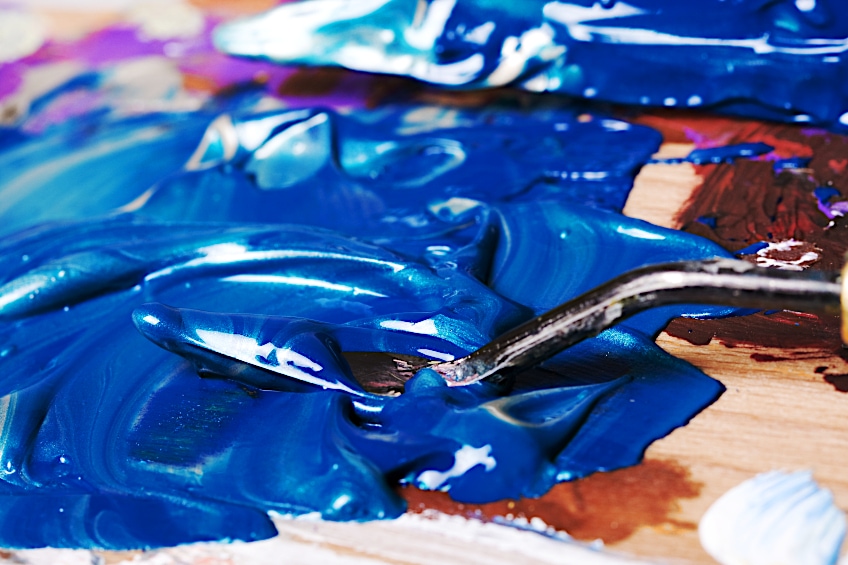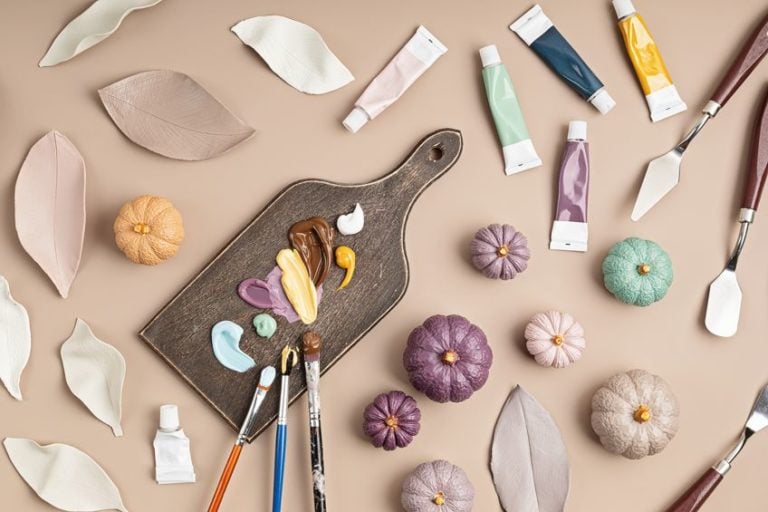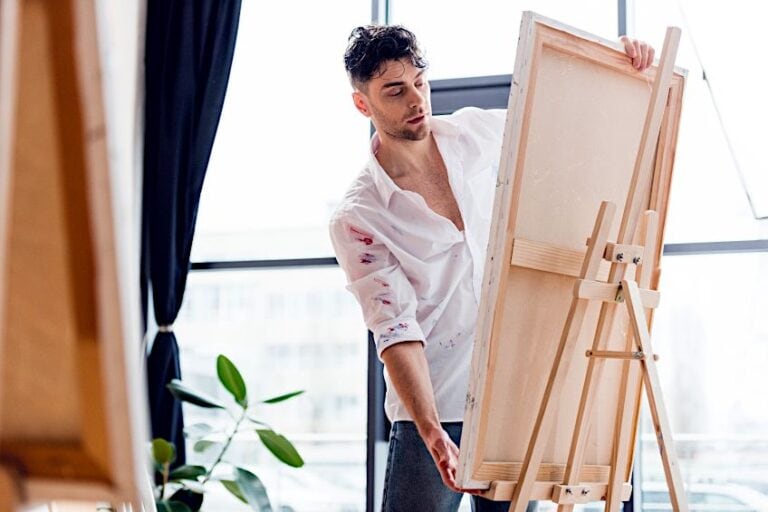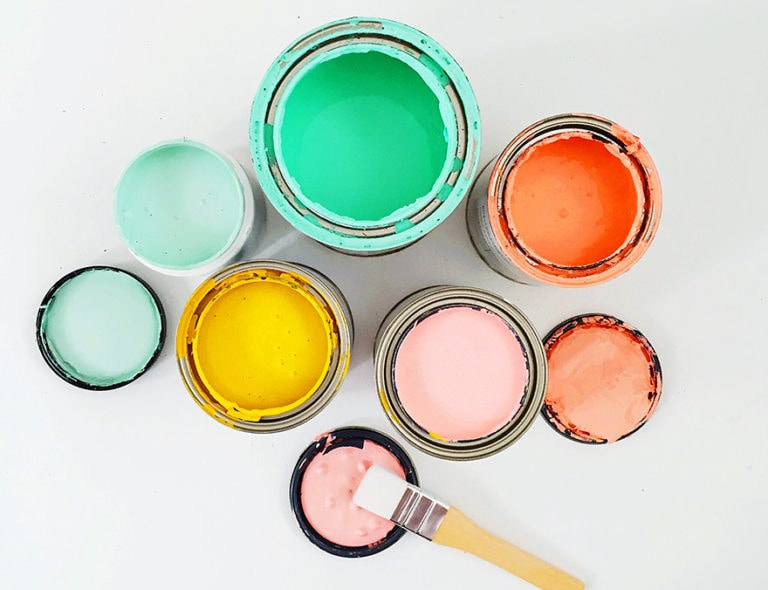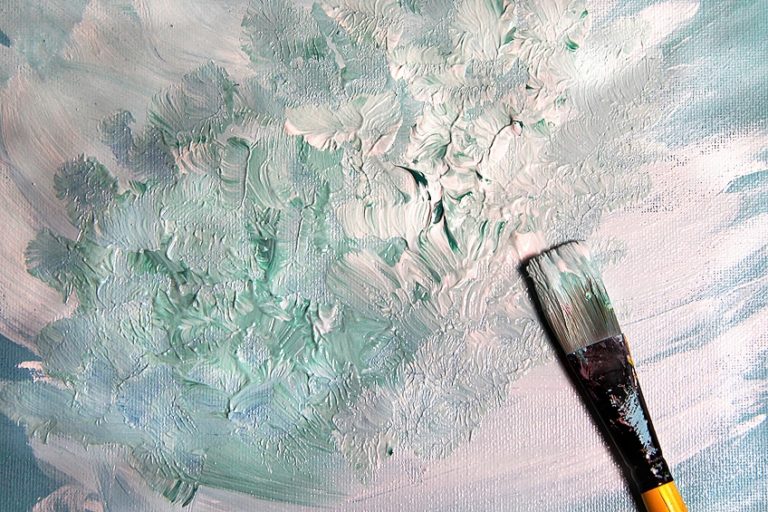How to Thicken Acrylic Paint – Adjusting the Texture of Acrylics
This post may contain affiliate links. We may earn a small commission from purchases made through them, at no additional cost to you.
Most crafters will get to a point where they find their acrylic paint is too thin or watery for a project. Sometimes you want to add an extra dimension to your artwork, leaving you to wonder how to thicken acrylic paint. Regardless of the method you choose to thicken your acrylics, it will invariably require the addition of something to your paint. Below we have outlined some popular DIY quick-fixes and a few traditional methods commonly used to make acrylic paint thicker.
Table of Contents
What Is Acrylic Paint?
Acrylic paint is a versatile medium for artists all over the world, which is loved for its affordability and convenience. Acrylics are composed of a suspended pigment, acrylic polymer emulsion, and a vehicle. The vehicle is what carries the binder and pigment. In acrylic paint the vehicle is water. This pigmented emulsion forms the gooey, water-soluble substance which we know as acrylic paint. When acrylic paint dries what actually happens is that the water is absorbed or evaporated and the resin particles fuse together. The paint now becomes strong and water-resistant. If you’ve encountered separated paint you’ve seen the binder in the form of the clear liquid substance that comes out of your tube before the colored pigment.
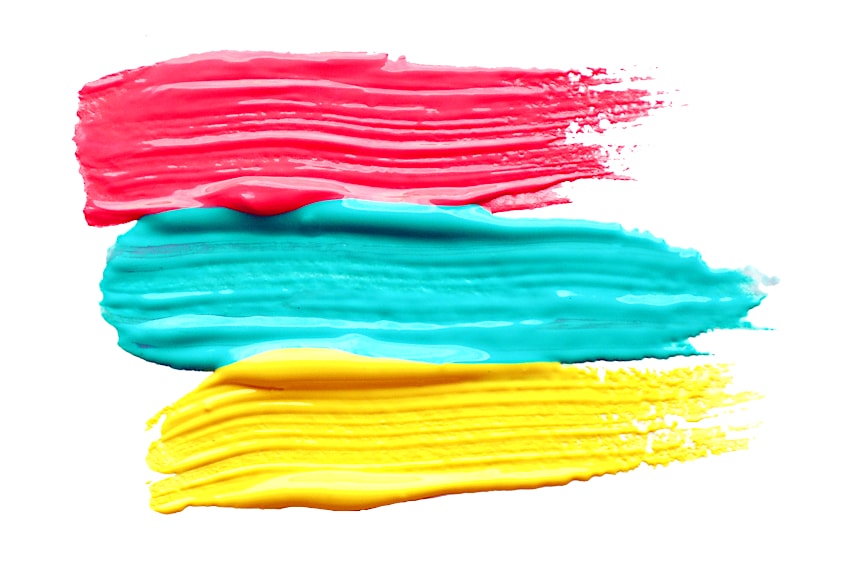
Paints may also contain additives like anti-foaming agents or surfactants. Each manufacturer has its own formula and standards regarding this. Manufacturers will even have differing amounts of pigment. Cheaper brands use fillers and dyes in their paints, as these cost less than pigment.
Common acrylics are the consistency of a thick but spreadable liquid. Their creamy texture means that they are applied with ease and dry quickly. Fluid acrylics have a thin consistency and flow with ease. They are ideal for splattering or dribbling paint, as well as for spraying and staining. Heavy-bodied acrylics are buttery and thick. They easily hold peaks and add texture to paintings. Thick textured paint allows for the building of visible layers and textures on your canvas without the need for added mediums. Heavy bodied acrylics, such as these, are perfect for impasto styles of painting.
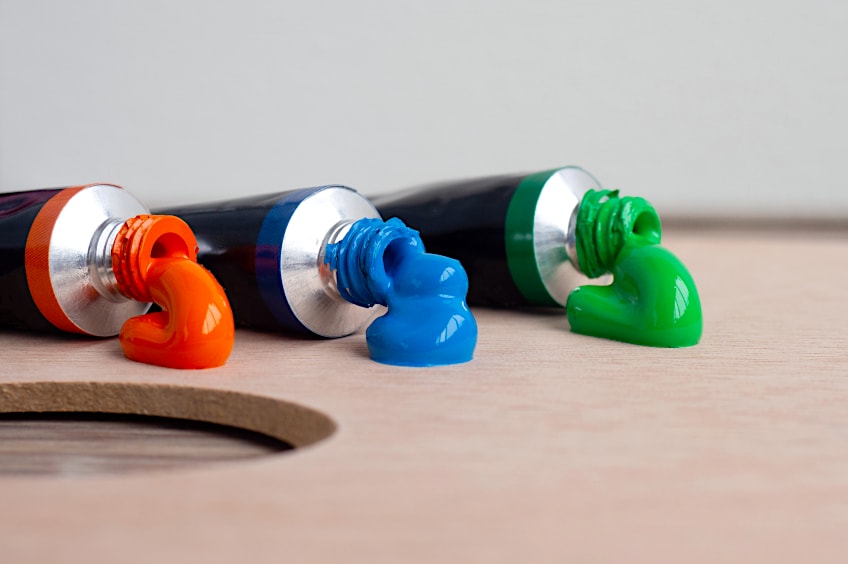
Artists love acrylics because they are affordable and easy to work with. Their water-solubility, mild odor, and fumeless, non-flammable nature add to their convenience. Acrylic paints can be easily washed off of brushes and surfaces without the need for thinners. You can thin acrylic paints with water to provide an effect similar to watercolor. Alternatively, an acrylic medium can be added to acrylic paint to change anything, from appearance and texture to drying time or thickness.
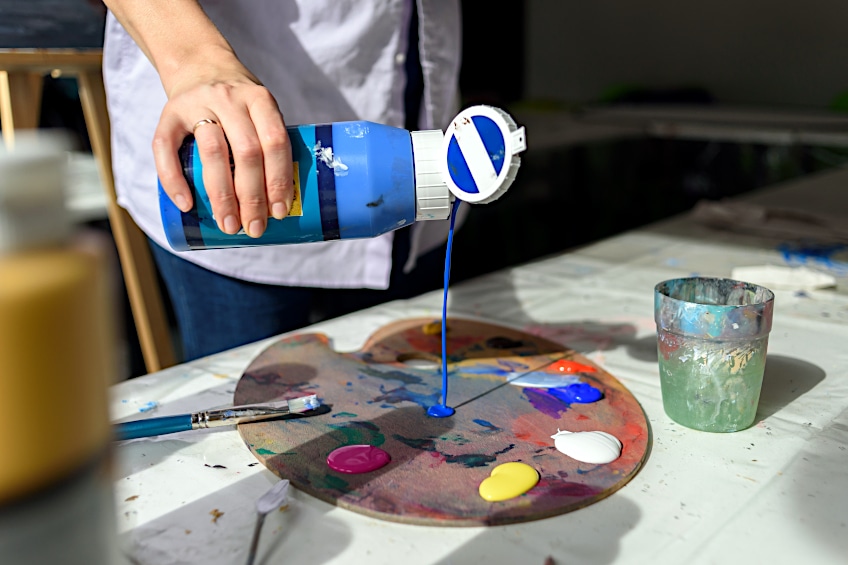
Why Would I Thicken Acrylic Paint?
Before we get into how to thicken acrylic paint, it might be necessary to discuss why you might want to thicken your paint. Just like some artists like to use thinned acrylics to do washes or watercolor-like pieces, some artists like to use thickened acrylics to add depth and texture to their work. Impasto is a painting technique where brushstrokes and painting-knife strokes are visible on the final piece, due to the thickness with which the paint is applied.
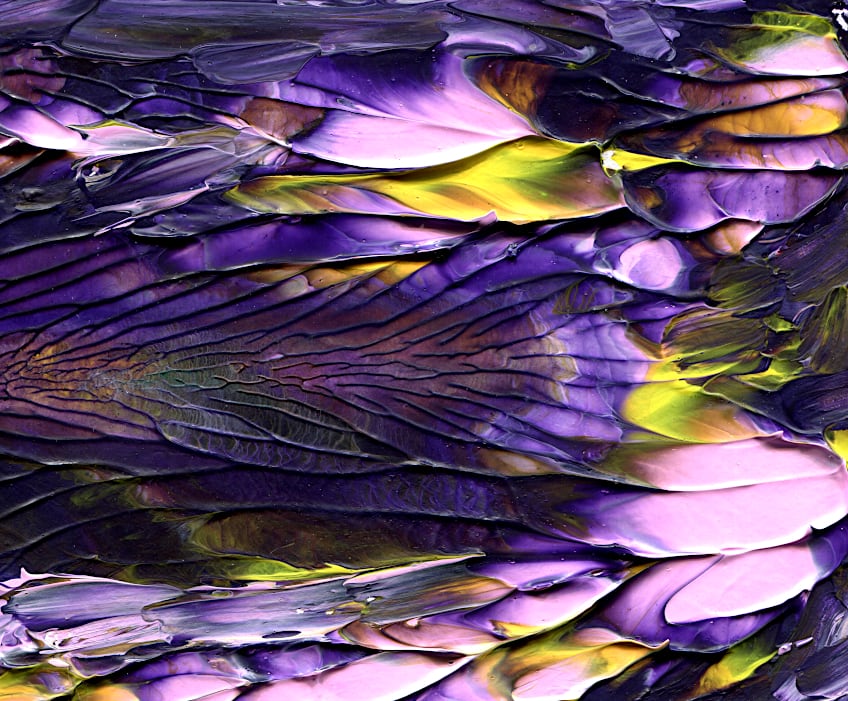
Paintings made using the impasto technique look as if they are coming out of the canvas. Many famous artists such as Van Gogh and Rembrandt frequently made use of the impasto technique in some of their most notable works. Impasto is a very expressive style of painting as it allows the completed piece to show a record of the painting process. The technique also allows the paint to be mixed onto the canvas rather than a palette. Many artists love to experiment with the impasto technique because it is a fun way to play around with texture and depth in landscapes, portraits, or still-lifes.
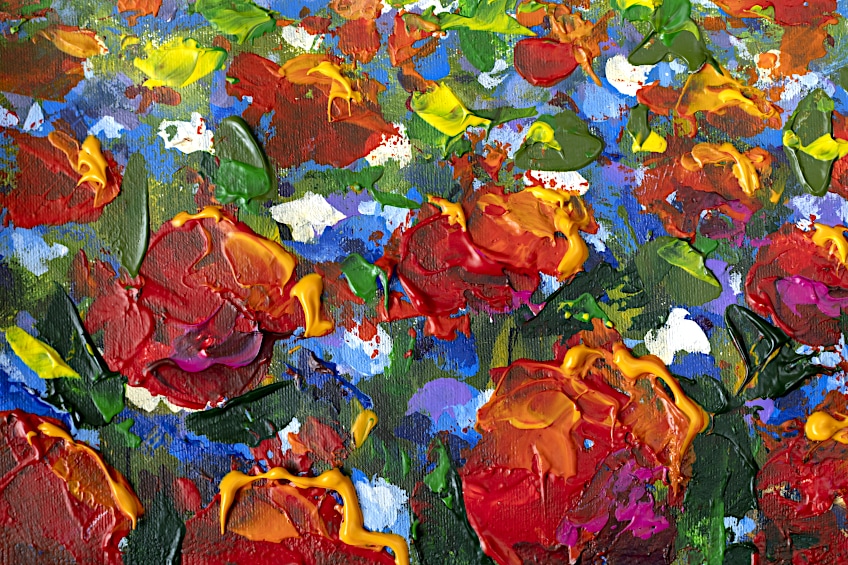
Another reason you may want to thicken acrylic paint is if you are not pleased with the thickness of a cheaper brand you bought, or if you accidentally bought the wrong thickness by not reading the label correctly. Sometimes paints that are a little past their sell-by date or that have not been stored properly can break down and become watery. Regardless of the reason you would like to thicken your acrylics, we provide various methods for thickening acrylic paint below.
What Can You Use to Thicken Acrylic Paint?
The two most traditional ways to thicken acrylic paint are to use modeling paste or a paint medium. These two methods are the most worthwhile as have the least serious downfalls. It is up to you to decide which one better suits your needs. If you are in a bit of a hurry or you find that ready-made mediums are a bit too pricey, you can try some DIY hacks for thickening acrylic paint. We have listed a few near the bottom of this article.
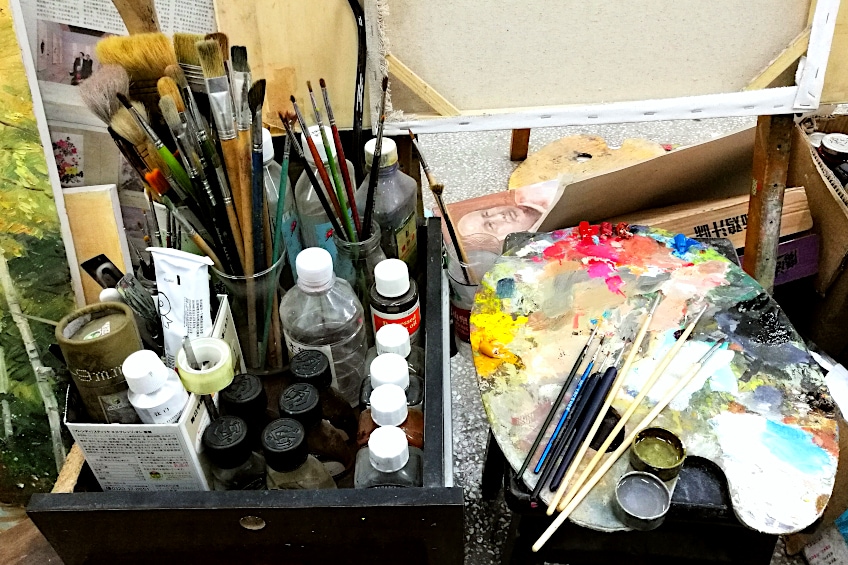
Modeling Paste
Modeling paste is a very thick, white substance that can be used to create three-dimensional surfaces on your canvas. You can mix your modeling paste with paint and then apply it onto the canvas and allow it to dry. Alternatively, you could apply the paste directly onto the canvas and paint it once it has dried. If you are mixing modeling paste into your paint, keep in mind that the color will be altered.
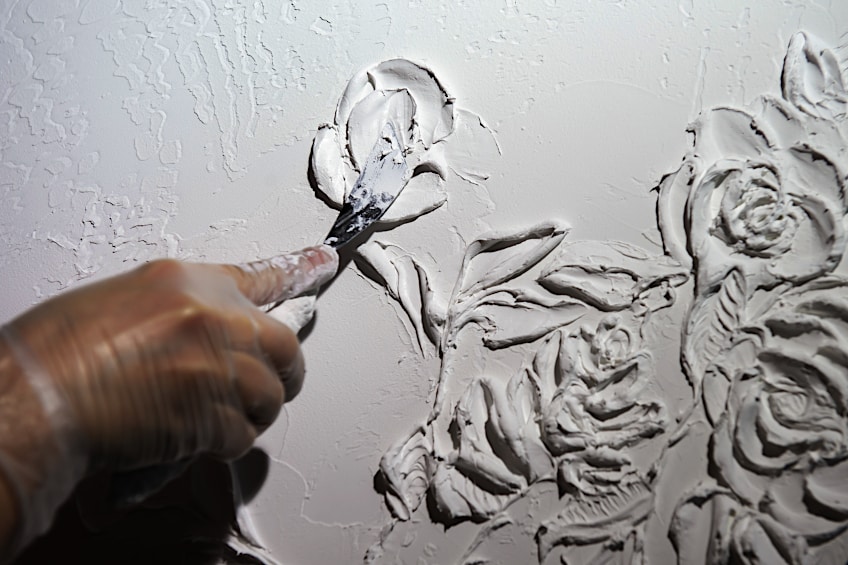
Since modeling paste is white, it can decrease the vibrancy of your paint upon mixing. On the other hand, there is no need to worry about the alteration of your colors if you apply modeling paste onto the canvas, shape it as desired, and then coat with paint once dry. Remember that modeling paste will create the thickest texture out of all the traditional methods, so it may prove more cost-effective for larger projects.
Working with a substance as thick as modeling paste can be a bit intimidating at first. The good news is that while it can seem difficult to work with, it is actually very simple with the right tools. We suggest using this modeling paste by Liquitex. Whether you are mixing your acrylic with modeling paste or painting the paste once dried, you can use the tips and techniques below.
How to Use Modeling Paste to Thicken Acrylic Paint
Use a palette knife to easily remove the paste from the tube and decide if you are going to mix your paste and paint together. If you are going to use your modeling paste to make acrylic paint thicker, then you can use your palette knife to do so. Keep in mind that modeling paste works best on a rigid surface like a wooden panel. If you want to use modeling paste on a canvas, we suggest that you choose to mix your acrylic with your paste rather than using it on its own.
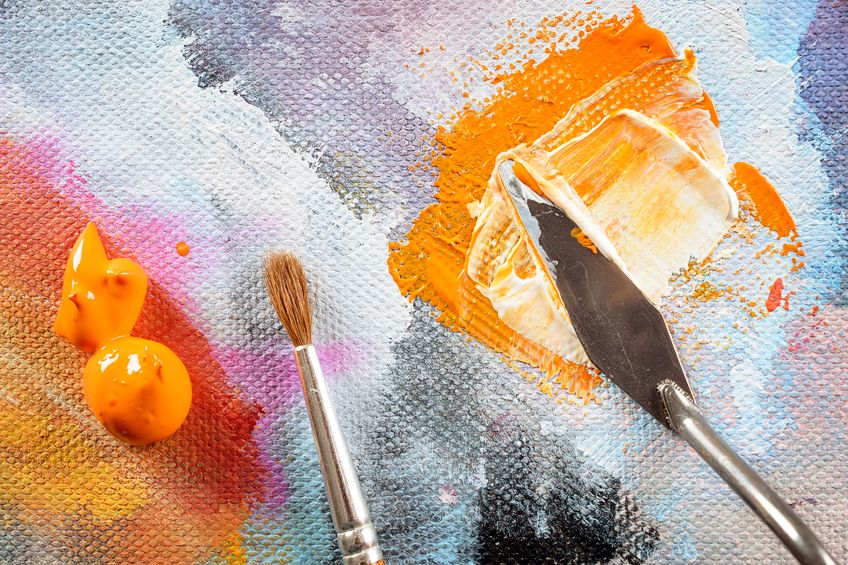
Mix the substances together until you have achieved the desired consistency. Make sure that you are adding the paste in small amounts and mixing thoroughly before adding more. Remember that the dried color may be different from what you see at this point.
To apply your now thick textured paint or plain modeling paste you can use a stiff-haired paintbrush or a palette knife. A stiff or coarse-haired brush will create smooth lines of texture on your canvas. On the other hand, a palette knife can be used to spread paint or paste over the surface in large swipes.
A palette knife can easily create peaks and ridges or can be used to scratch the surface of the paint. Using your palette knife, you can also press down firmly into the paint or paste and lift it to create a lot of little ridges on the canvas. If you make any mistakes at this point then you can wipe it away or scrape off the paint or paste using a palette knife. The amount of time you have to remove mistakes before they dry varies depending on the temperature, humidity, and air movement of the room you are in. The brands of products you are using and how they interact with each other will also affect drying time.
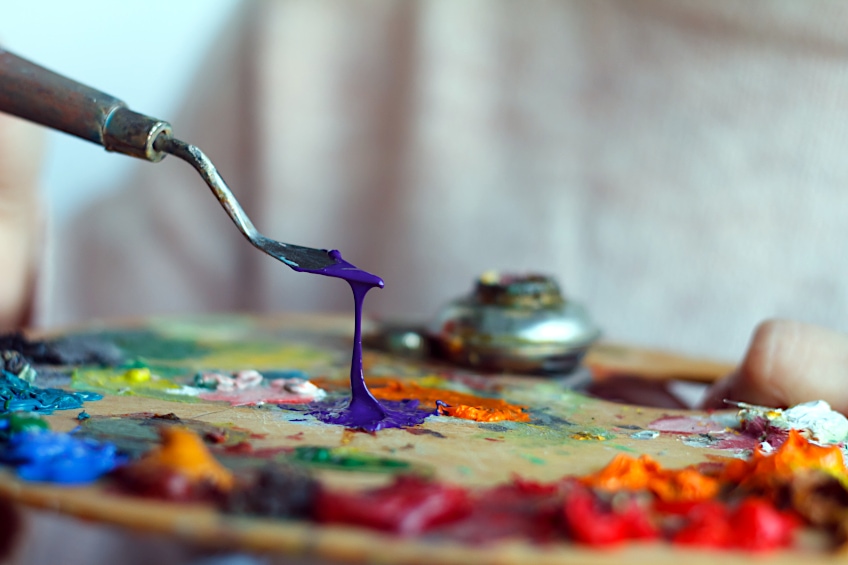
If you added paint to your modeling paste then you now just let it dry and you are done! If you used the modeling paste on its own, then there are still some steps for you after it dries. Firstly, you can sculpt the dried paint even further by carving or cutting off pieces until you are happy with how it looks. If you discover that you have made any big mistakes and your paste is already dry, you will have to use sandpaper to remove it.
If you are happy with the shape, then it is time to paint over it. Experiment with varying degrees of pressure to achieve different effects on your modeling paste. If you brush lightly, the paint will only sit on the ridges of your paste. If you brush firmly, the paint will apply on top of and between the ridges. Another great idea is to use fluid paints to flow over the ridges of your dried paste and then puddle in the concaves.
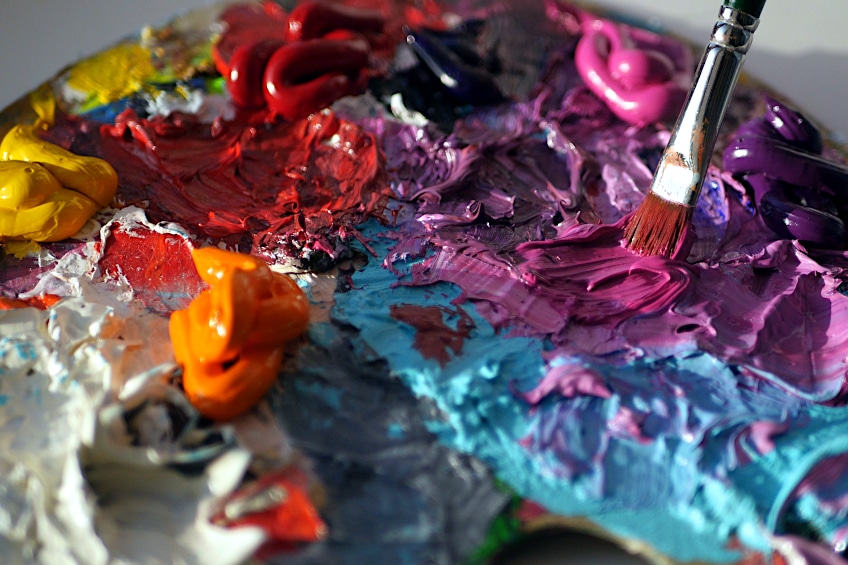
Experimenting with different techniques using modeling paste with acrylic paint is a fun way to mimic the textures of skies, grass, trees, hair, oceans, and more. Modeling paste is a great way to add dimension to your paintings and is exciting to work with.
Acrylic Gel Medium
Acrylic gel medium is a creamy, white acrylic paint thickener that dries to become transparent. This means that thickening gel for acrylic paint generally does not alter the hue of your paints upon mixing. To stay on the safer side, always check what finish your gel medium has as certain fillers may affect the colors of your paints. Unlike modeling paste, gel mediums can have different finishes such as clear, opaque, matte, or gloss. Acrylic gel medium also has adhesive properties that allow it to work well with mixed media or collage pieces. A great gel medium that we highly recommend is this matte gel medium by Liquitex.
Furthermore, while modeling paste has a flatter and more solid form, a medium gel is softer and rounder. Modeling paste is textured and full-bodied while gel medium is fluid and dynamic, even once dried. Thickening gel for acrylic paint is a great option for working on canvases, as it is not prone to cracking on flexible surfaces. Much like with modeling paint, you can choose to apply the gel medium on its own beforehand, and paint it once dried. Keep in mind that acrylic gel mediums shrink slightly as they dry. You might need to add additional layers after coming back to your piece later on if you find that your peaks are not as high as when you left them.
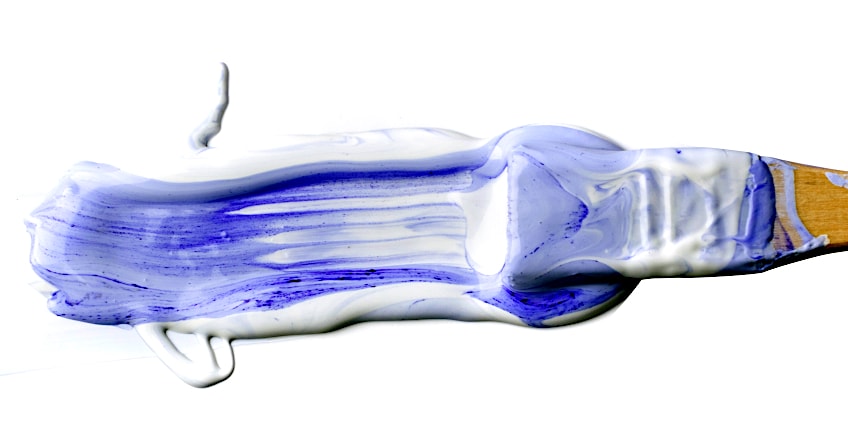
Gels are white when wet, but dry clear. Adding gel to your paint will lighten it briefly while wet but since the gel will clear as it dries, the color darken slightly. Make sure to properly read the instructions on your medium beforehand, to be sure that there are no other fillers that may permanently affect the color.
Remember that acrylics dry darker even when no gel has been added. This happens because the acrylic emulsion within the paint is cloudy too. Over time you will learn to use slightly lighter shades while working so that they dry to be the exact shade you want.
How to Use Acrylic Gel Medium to Thicken Acrylic Paint
Using gel medium to make acrylic paint thicker is quite simple. Much like before, you will add the thickening gel for acrylic paint in small amounts while mixing thoroughly. Keep doing this until reaching the desired thickness for your project, and then get started with painting! You should be able to add as much gel medium as you like to your acrylic without facing a problem but to be safe always make sure you read the manufacturer’s instructions properly before doing this.
Alternatively, place the gel directly on your surface and allow it to dry, adding the paint on top once dry. This allows you to build up texture separately from your acrylics and can save you some money as you won’t be wasting your paint on layers that will ultimately be hidden.
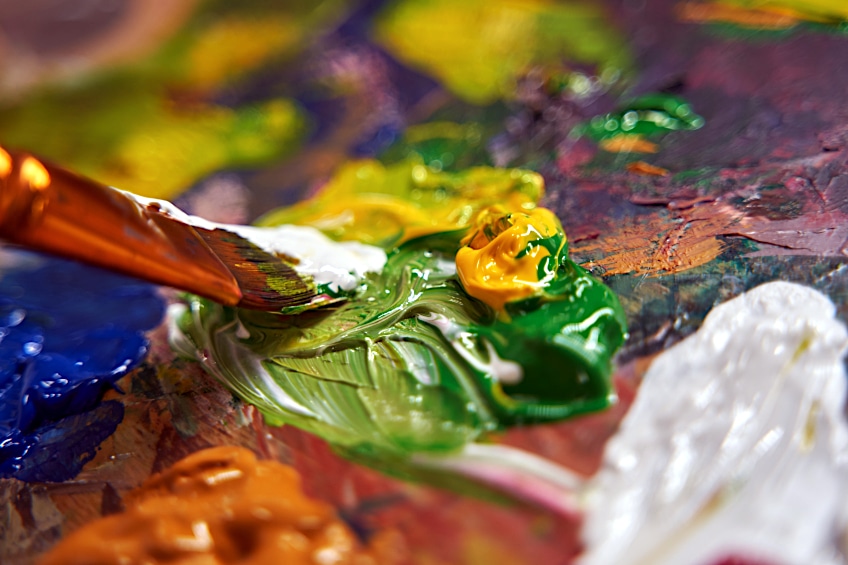
Try using a palette knife and brushes of different coarseness to experiment with texture in your paintings. Just like with modeling paste you can try creating long smooth streaks of paint with a palette knife, or stamping it down and lifting it to create many small peaks on the surface of the canvas. You can also sculpt away dry pieces of plain acrylic gel like you can with modeling paste, and then paint over it. But this may not be as easy or effective as with modeling paste.
Another great idea while using a paint medium to make thick textured paint is to add sand, glitter, sawdust, or even pencil shavings to the paint. This will create even more interesting surfaces on your painting. Alternatively, you can purchase a sand or glass bead textured acrylic medium to avoid all the fuss of collecting textures to add on your own.
Gesso
Gesso can be an alternative option if you are wondering how to thicken acrylic paint. Although you will need to use extra thick gesso like this super heavy gesso, or else you will just end up thinning your paint. Furthermore, gesso as an acrylic paint thickener will alter the color of your paint and dry to a matte finish. If you have no issue with this, then gesso is another option to consider when making thick textured paint at home.
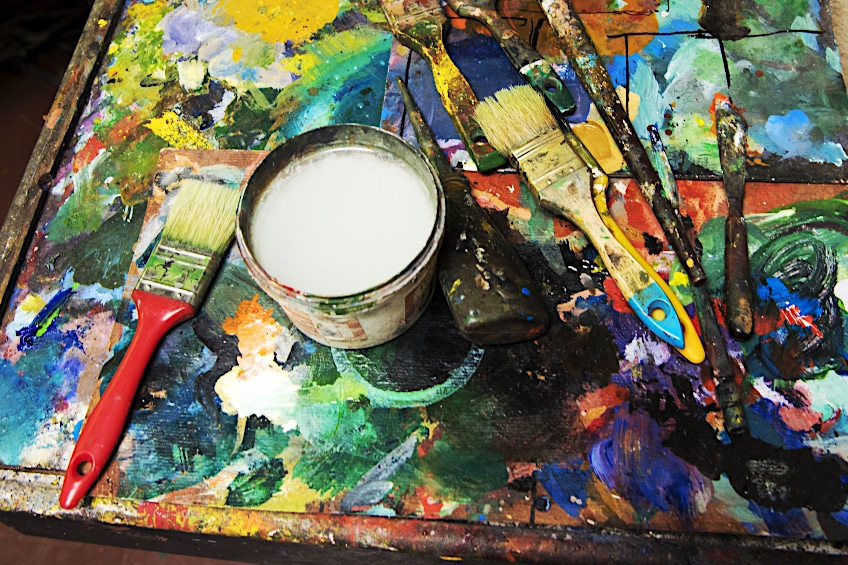
How to Use Gesso to Thicken Acrylic Paint
As in the previous two examples, just slowly mix your gesso into your paint in small amounts until you are satisfied with the consistency. Then have fun experimenting with different techniques and tools to get the textures you want. The great thing about textured paint is that it helps you explore a whole new aspect of painting. Textured paintings allow for a whole extra dimension to be explored on the canvas, as a means to create depth or allow for deeper emotional expression.
| Modeling Paste | Gel Medium | Gesso | |
| Alters Color of Paint | ✔ | ✘ | ✔ |
| Different Finishes Available | ✘ | ✔ | ✘ |
| Can be Mixed Into Paint | ✔ | ✔ | ✔ |
| Can be Applied on its Own to Add Texture | ✔ | ✔ | ✔ |
| Different Textures Available | ✘ | ✔ | ✘ |
| Can be Used on a Rigid Surface | ✔ | ✔ | ✔ |
| Can be Used on a Flexible Surface | ✘ | ✔ | ✔ |
| Can be Sculpted or Carved Away Once Dry | ✔ | ✔ | ✔ |
| Can be Applied on its Own and Painted Once Dry | ✔ | ✔ | ✔ |
| Shrinks as it Dries | ✘ | ✔ | ✔ |
Joint Compound DIY Thickener
You may already have joint compound laying around in your garage and might consider using it as an acrylic paint thickener. Joint compound is cheap, easy to find, and mixes well with paint so it seems like a great alternative to traditional thickening mediums. One issue with this idea is that joint compound can cause cracks in your painting, especially if it is on a stretched canvas. A solid surface or a canvas with rigid support is much better in this case. Joint compound can also affect the color of your paint and lessen the amount of time it takes for your paint to dry. Color is also affected by adding joint compound as it lightens paint to a large degree.

PVA or Talcum Powder DIY Thickener
Mixing PVA and talcum (baby) powder into acrylic paint is another popular way to try thickening your paint cheaply at home. One of the downsides to this method is that when combined they can leave your paint quite greasy while talcum powder on its own can make paint brittle and crumbly. Aside from that, either approach is an affordable and easy DIY for anyone wondering how to thicken acrylic paint. Both PVA and talcum powder can be found at most hardware or department stores. This method will alter the color of your paints.
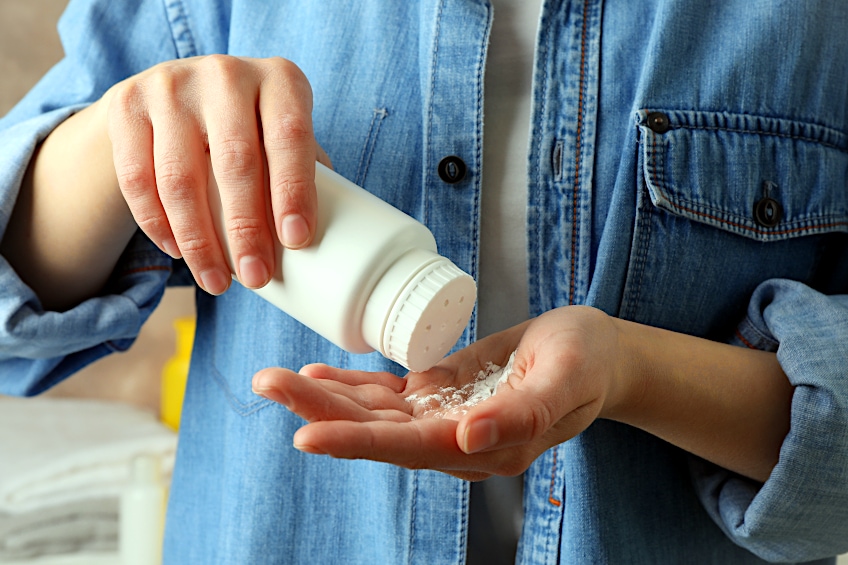
Talcum powder on its own will need to be mixed with water in small amounts to create a smooth paste. Once this paste has reached the right consistency, you can mix it with your paint to thicken it. Alternatively, you can add PVA and talcum powder to your paint by following these simple steps:
- Add one part talcum powder into one part PVA glue in a container
- If you want your paste to be thicker, keep adding talcum powder until satisfied.
- Evenly mix into your paint and begin painting
Corn-Starch or Flour DIY Thickener
Yet another popular DIY hack for thickening acrylic paint is to use cornstarch or flour to create a thickener. Many crafters and artists use this hack to thicken their paints in a hurry or when money is running a bit low. Flour and cornstarch give acrylic paint a nice coarse texture, although this can be achieved using something like this stucco textured gel medium. Overall, while cornstarch and flour are both affordable and easy to use to make acrylic paint thicker, they do have a few downsides.
Cornstarch and flour can encourage mold and mildew growth on your paintings. They can also cause unsightly cracking and flaking over time. This is because adding these powders to your acrylics makes them more brittle. Pastes made from cornstarch and flour will come out an off-white color and will alter the colors of your paints upon mixing. These DIY thickening pastes can also affect the water-resistant qualities of some acrylic paints. Your acrylics will also dry faster using this method, and may be prone to getting “gummy”. This gumminess can make painting and mixing colors very difficult.

If you choose to use cornstarch or flour as an acrylic thickener, do so at your own risk. Until you have experimented a bit, it may be a good idea not to gift any paintings you make while using cornstarch or flour to thicken your paint.
How to Thicken Acrylic Paint Using Cornstarch
We’ll start by explaining how to use cornstarch to make a thickening paste for acrylic paint. This method requires just two tablespoons of cornstarch as well as one and a half cups of water. You will also need a pot/pan, a stovetop, a mixing spoon, and a jar/Tupperware.
- Mix the water and cornstarch together and pour into a pot or pan on low heat
- Stir consistently until you reach the desired consistency. If you would like your paste to be thicker you can add more cornstarch
- Remove from the heat. Set it aside to cool
- Once cooled you can add the mixture to your paint in small quantities while being sure to mix thoroughly
- Keep any leftovers in a well-sealed jar or Tupperware, out of direct light, and heat until needed again

How to Thicken Acrylic Paint Using Flour
Using flour to make a thickening paste for acrylics is very similar to using the cornstarch method above. You will need at least 2 tablespoons of flour and 1.5 cups of water. A container for any leftover paste will also be necessary.
- Add your water to a heated pan and let it warm
- Sift your flour into the water and stir until reaching the desired consistency. Add more flour if you would like a much thicker paste
- Remove from the heat. Set aside to cool
- Once cooled you can add the mixture to your paint in small quantities while being sure to mix thoroughly
- Keep any leftovers in a well-sealed jar or Tupperware, out of direct light, and heat until needed again
There are many ways to thicken acrylic paint, from buying a readymade thickening product to trying a DIY solution with things you have lying around at home. As long as you remember to account for possible color and texture changes you will be pleased with the results of whatever method you choose.
Frequently Asked Questions
Should Acrylic Paint Be Thick?
Acrylic paint can come in many different consistencies. Each consistency has its own applications for which it is best suited. If you have a paint that is supposed to be thick but instead is rather runny, check the expiry date or contact the manufacturer.
Why Is My Acrylic Paint So Runny?
Expired paint can thin out or separate and cheaper brands can be more watery than advertised. Acrylic paint can also thin out if the container has not been sealed properly, or if the container has not been stored in the appropriate way.
What Do I Do if I Leave My Paint Out and It Becomes Runny?
This would happen because a lot of the components of the paint may sink down to the bottom of the container. Try giving it a good stir or shake, otherwise try some of the ideas above to thicken your paint again.
How Do You Make Acrylic Paint Dry Faster?
You can try lowering the humidity and raising the temperature of the room. Another idea is to build up thickness layer-by-layer, rather than applying paint in one large layer. Finally, you can make sure that the room is well ventilated by opening a window or placing a fan in the room. Don’t point the fan directly at the paint.
Larissa Meyer is a 32-year-old mother from Michigan and creative spirit since childhood. Her passion for painting and drawing has led her to an education as an illustrator and a career as a freelance graphic designer. She has a Bachelor of Fine Arts in Illustration and a degree in Graphic Design. Larissa is a talented artist who is able to master a wide range of styles and techniques to bring her artistic vision to life. Her greatest passion is currently fluid painting and epoxy resin art. Larissa’s love for art and her knowledge and experience in illustration make her the perfect Creative Director for our fluid-painting.com team. She is the creative head of our team and shares her passion and knowledge with our community through articles and tutorials.
As a mother of a 2-year-old daughter, Larissa also understands the importance of fostering creativity in early childhood. She uses her experience and knowledge to help other parents inspire their children and develop their artistic skills as well.
Learn more about Larissa Meyer and about us.

